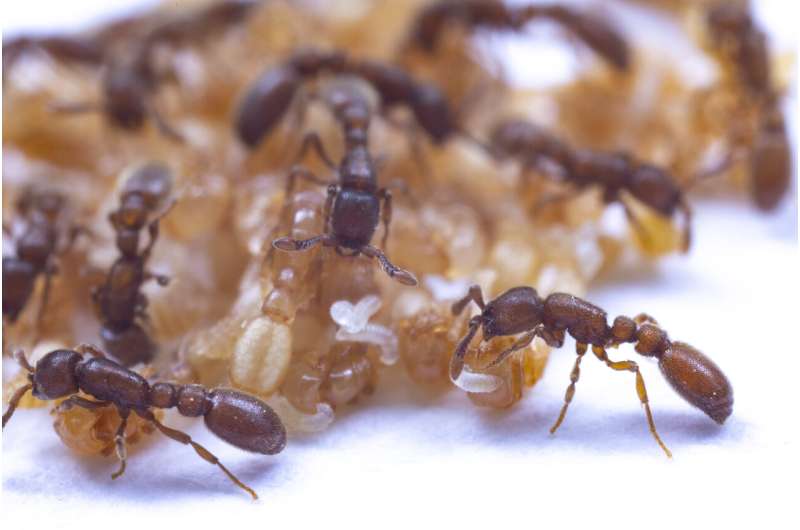
Life in an ant colony is a symphony of subtle interactions between insects acting in concert, more like cells in tissue than independent organisms bunking in a colony. Now, researchers have discovered a previously unknown social interaction that unites the colony, linking ants across developmental stages: adults, larvae, and pupae (an immobile stage, not unlike a butterfly’s chrysalis, during which ants transition from larvae to adults).
The study, published in Nature, reveals that pupae secrete a never-before observed fluid that adults and larvae immediately drink. The health of the entire colony appears to hinge on the prompt consumption of this nutrient-packed fluid—the larvae need it to grow and, if adults and larvae fail to drink it, the pupae die of fungal infections as the fluid builds up around them.
The fluid is rich in nutrients, the researchers found, as well as psychoactive substances, hormones, and some components found in the royal jelly that honeybees reserve for queen bee larvae. And while ants of all ages seem to enjoy the fluid, young ant larvae need it—those deprived of the fluid in their first four days of life fail to grow, and many eventually die.
“The first few days after hatching, larvae rely on the fluid almost like a newborn relies on milk,” Kronauer says. “The adults also drink it voraciously and, although it’s not clear what it does to the adults, we’re confident that it impacts metabolism and physiology.”
Anatomy of a superorganism
The ant colony is sometimes referred to as a superorganism—one unified entity composed of many organisms working in concert. Indeed, ants relay information by swapping chemical signals in ways analogous to how cells communicate in tissue. These include pheromones, which often convey short-term information, and social fluids, which have the potential to effect long-term metabolic and behavioral changes. The discovery of the pupal social fluid and its role in connecting adults, pupae, and larvae, adds context to this understanding of ant colonies as interdependent superorganisms.
“Pupal social fluid is the driving force behind a central and hitherto overlooked interaction network in ant societies,” Snir says. “This reveals a new aspect of dependency between larvae and pupae, and pupae and adults.”
“This study only provides a glimpse into the intricate interaction networks of insect societies,” Snir says. “Our long-term goal is to gain a deep understanding of the neural and molecular mechanisms governing social organization, and how these mechanisms evolved.”
Complete article at Phys.org.
Apparently, the survival of the ant colony departs from the Darwinian concept of survival of the fittest. In contrast, a high degree of interdependence, “linking ants across developmental stages,” is essential for the survival of the whole colony.